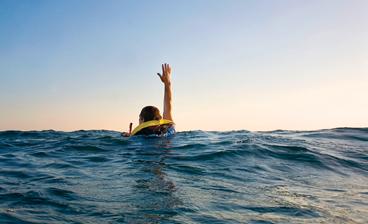
Coast Guard image
A post by John Selwyn Gilbert on Scuttlebutt.
I was knocked overboard – at dusk – about 25 years ago in the Governor’s Cup on the Chesapeake Bay when the J/35 I was racing death-rolled to weather while I was trimming the spinnaker. As soon as I hit the water, I knew the boom was coming down and I actually pushed myself as far under as I could to avoid it. When I came up, the boat was already far away from me.
I initially tried to swim to the buoy they threw, but realized there was no way I could catch up with it heading downwind in 25+ knots of breeze. What really helped was actively telling myself, “Don’t panic, just float with the breeze & current. They will be back to get me.” It really did seem like an eternity (It was less than 7 minutes, I think) but they did make it back and my firefighter/EMT bowman pulled me back on board. I couldn’t lift my arms for hours – I was exhausted.
My boat did a great job coming back to me and followed much of what is listed here, including having a spotter. Our lessons learned, In addition to what is listed in the article:
1. Recognize your own limitations: I trimmed in very heavy air for too long, and got tired. I had very little left for myself once I was in the water. For safety sake – take a break.
2. Always flake all lines, all the time: The lazy guy, sheets AND halyard were not flaked, slowing down recovery. The spinnaker actually filled inside the forestay on the opposite gybe and the boat rounded up and away from me.
3. Just because you can see the shore doesn’t mean you could reach it on your own! Don’t take ANY heavy weather for granted: Both my skipper and I are offshore sailors, and we remarked that given the same conditions offshore, we would have been wearing PFD’s and harnesses.
4. Wear a lifejacket. Not sure if I could have dunked under enough to avoid the boom while wearing one, but I never want to be caught in the water again without one.
– Emily Hektner Decker
A most useful article about a worryingly dangerous accident which could have turned out badly. Thank goodness it didn’t.
Two points: a Dan buoy is a useful thing to hurl into the water at or near a man or woman overboard. I am aware of two different types, one with a line attached, to haul the casualty back in, the other free-floating, to mark the casualty’s position and provide extra buoyancy.
Secondly – have a 20 foot coil of line (a thin mooring line) handy at all times.
If/when you get the boat close enough to the person overboard, you can drop a loop over their shoulders but – much more importantly – you can fashion a loop into which the casualty can put a foot, securing the rope to any available cleat and dropping the loop over the side.
To lift a human being in wet clothes three or four feet or five feet into the air and over the side of the boat is incredibly difficult.
If the casualty can use the remains of his/her strength to provide the initial lift, it will make the impossible possible.
For some reason this simple, helpful tip is not taught by British organizations that train amateur sailors.
I can’t think why not.
– John Selwyn Gilbert